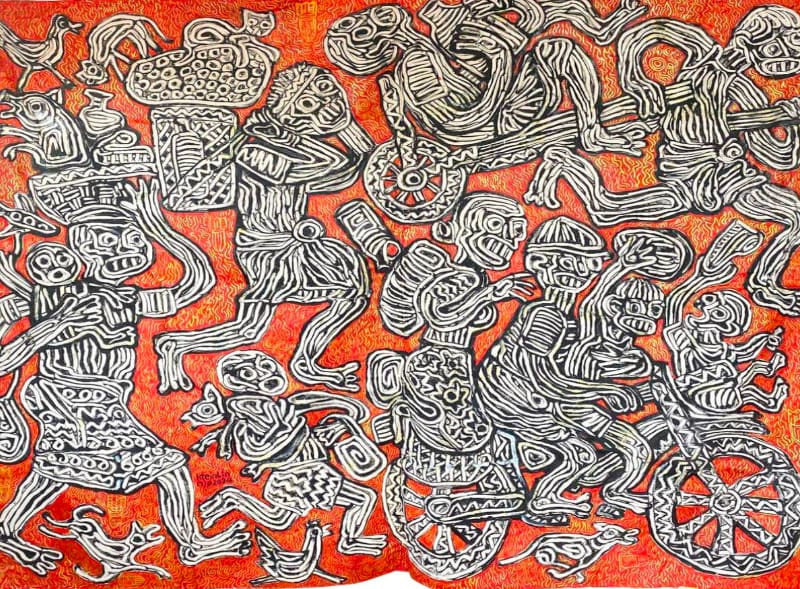La Galerie Retour De Voyage, à L’Isle-sur-la-Sorgue, présente « Le Fil Intérieur », une exposition qui rassemble quinze œuvres de l’artiste birman Htein Lin, dont neuf réalisées clandestinement en prison, quatre peintes sur des couvertures, un pendentif humoristique et subversif détournant l’alphabet Birman et une installation de savons sculptés.
Ces œuvres, traversées par la douleur, l’ironie et la mémoire, interrogent la place de l’artiste face à la répression politique, à l’emprisonnement, à la guerre civile et à l’exil.
Malgré les conditions extrêmes de création, elles témoignent d’une force intérieure inébranlable et d’une résilience rare.
Créer derrière les barreaux : l’art comme voie de survie et de transformation
Emprisonné pendant près de sept ans pour ses convictions, Htein Lin a produit en captivité une œuvre plastique d’une inventivité saisissante. Sans pinceaux ni toile, il invente des techniques à partir de ce qu’il a sous la main : roues de briquet, seringues, savon, filets, bouts de miroir, peinture trouvée ou troquée. Ces matériaux de fortune deviennent les instruments d’une quête : rester vivant intérieurement, continuer à penser, se souvenir, pardonner. Sa pratique artistique s’enracine dans les valeurs bouddhistes de compassion, de lucidité et de non-violence.
Les œuvres de l’exposition Htein Lin

Portraits de résistance douce
- Self Portrait : L’un des premiers monotypes créés en prison. Les traits ne cherchent pas à reproduire un visage mais à explorer ce que l’enfermement grave dans le corps et dans l’âme. La barbe – interdite en prison – devient un symbole discret de désobéissance.
- The Door : D’abord imaginée comme une station spatiale, l’œuvre révèle peu à peu… une porte de prison. Sans intention polémique, l’artiste laisse émerger ce que son inconscient n’a jamais cessé de porter : l’image du quotidien carcéral.
- Mission 1 & 2 : Nourries par ses lectures scientifiques en prison, ces œuvres évoquent l’espace, les planètes, l’infini. Le ciel devient un terrain de méditation et d’évasion mentale.
- Playground : Inspirée par un souvenir doux de sa fille, cette œuvre suspendue évoque le mouvement, la légèreté, la continuité de la vie au-delà des murs.




Les femmes, la danse, la mémoire
Privé de toute présence féminine pendant des années, Htein Lin convoque par le dessin les figures du théâtre traditionnel birman. Il se souvient des danseuses du genre Anyeint, dont il partageait parfois la scène avant son arrestation. À travers elles, il évoque l’harmonie, la beauté, l’identité culturelle qu’aucune répression ne peut effacer.
Les œuvres Poem of Dancer Thin Thin Kyu, Apyodaw Yain, Three Dancers, Dancers from Afar :
sont autant d’hommages à des gestes, à une culture, à une joie sobre et digne, restée vivante au fond de lui.
L’humour comme arme douce
Htein Lin a créé un pendentif qui joue sur l’alphabet birman… auquel trois lettres manquent.
Ce détail discret invite le spectateur à réfléchir. Loin d’une dénonciation directe, l’œuvre propose un jeu silencieux, une forme d’ironie pour interroger la censure.
Le pendentif est aussi reproduit sur une grande toile.
Les déplacés, la guerre, l’appel à la prise de conscience
Fiery Hell 3&4 : Peintes sur des couvertures, ces deux œuvres deviennent toiles de dénonciation. Elles illustrent l’exode forcé des populations rurales du Myanmar, fuyant la guerre civile. Femmes, enfants, vieillards, bêtes de somme traversent un paysage d’incendies. Les flammes rouges et dorées, traitées avec une intensité dramatique, traduisent la violence des déplacements, l’arrachement et la perte. Elles sont néanmoins autant de prières visuelles pour ceux qui, malgré tout, continuent à avancer
Une voix singulière dans l’art contemporain asiatique
Htein Lin est né en 1966 en Birmanie. Étudiant en droit, artiste de scène, il devient une figure des mouvements démocratiques. Il est emprisonné à plusieurs reprises dans sa vie, a vécu au Royaume Uni avant de revenir au Myanmar, d’où il ne peut plus partir, privé de passeport. Il continue à créer, pour ouvrir un espace d’écoute, de mémoire et d’attention.
Son art est un témoignage et un chemin de paix intérieure dans un monde fracturé.

